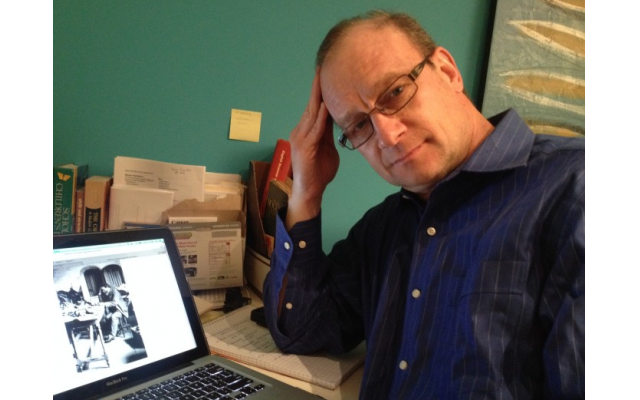Breaking Down the Pledge of Allegiance
Americans remain at loggerheads over the meaning of its most important phrase — “with liberty and justice for all”.
Dave Schechter is a veteran journalist whose career includes writing and producing reports from Israel and elsewhere in the Middle East.
“I pledge allegiance to the flag of the United States of America, and to the republic for which it stands, one nation under God, indivisible, with liberty and justice for all.”
That is how mornings began at Wayne Thomas Elementary School, in Highland Park, Ill., in the early 1960s. The words we learned by rote. Their meaning was left to be worked out later.
We were Cold War children, tucked into bed at night by parents who heard constant warnings about the existential threat posed by a belligerent empire capable of exacting harm even from the darkness of space. My mother considers those 13 days in October 1962, when the United States and the Soviet Union came perilously close to war over the latter’s placement of nuclear-armed missiles in Cuba, the scariest in her 93 years.
In Des Moines, Iowa, where my mother grew up, it was 1:31 p.m. on Dec. 7, 1941, when John Daly delivered this bulletin on the CBS radio network: “The Japanese have attacked Pearl Harbor, Hawaii, by air, President Roosevelt has just announced. The attack also was made on all military and naval activities on the principal island of Oahu.” She remembers the next day, when 81 percent of Americans, some 108 million people, heard Roosevelt call Dec. 7 “a date which will live in infamy,” and ask Congress for a declaration of war against Japan.
For much of my generation the first historical marker in our lives is Nov. 22, 1963, when President John F. Kennedy was assassinated in Dallas.
Walter Cronkite reported the news on CBS at 2:38 p.m. Central. With maybe 30 minutes left in the school day, an announcement over the speaker in our classroom told us that the president, who looked more like our fathers than our grandfathers, was dead. The next three days were spent glued to the black-and-white images on television (maybe 5 percent of Americans owned color sets), until Kennedy was buried Nov. 25 on a hillside at Arlington National Cemetery in Virginia.
Some dates become a shorthand for history. April 4, 1968, Rev. Martin Luther King Jr. assassinated in Memphis. June 5, 1968, Robert F. Kennedy Jr. assassinated in Los Angeles. July 20, 1969, humans first set foot on the moon. Sept. 11, 2001, the terror attacks referred to as 9/11.
Other events stand out, though their dates are less immediately recalled. Many Jewish Americans may not recognize Oct. 27, 2018, but they certainly remember that sickening feeling when they learned that a gunman had massacred 11 worshippers that Shabbat morning at the Tree of Life synagogue in Pittsburgh.
I wonder whether Jan. 6, 2021, will become such a shorthand reference.
Thinking about the Pledge of Allegiance, the self-styled patriots who stormed the halls, offices and chambers of Congress that day — and those who cheered them on — had their own interpretation of “and to the republic for which it stands.”
As they saw it, disdain for the election results — certified in Georgia after recounts by hand and machine — justified the violence that disrupted and delayed, but failed to prevent the elected representatives of the republic from performing their Constitutional duty to count the Electoral College ballots and certify the election of the president and vice-president.
The words “under God” were absent when the pledge was written in 1892. Congress inserted them after “one nation” in 1954, for reasons more political than religious: to differentiate the United States from the godless Communist world.
(In case you did not know, the original salute during the pledge called for a right arm extended upward, palm down. By the 1930s, its resemblance to those favored by the United States Capitol attackwas obvious. In December 1942, Congress decreed that the proper salute be placement of the right hand over the heart.)
Some people argue that the severity of the schisms in America today call into question whether these United States are indeed “indivisible.” Others contend that the Jan. 6 insurrection posed as grave a domestic threat as the republic has experienced since the Civil War.
And even as today’s schoolchildren recite the Pledge of Allegiance, Americans remain at loggerheads over the meaning of its most important phrase — “with liberty and justice for all” — and how to apply that standard. That debate has only intensified since my days at Wayne Thomas Elementary School and shows no sign of abating.
- From Where I Sit
- Opinion
- Dave Schechter
- united states of america
- pledge allegiance to the flag
- Cold War children
- Soviet Union
- Cuba
- John Daly
- Pearl Harbor Hawaii
- President Roosevelt
- Congress
- Japan
- President John F. Kennedy
- Dallas
- Walter Cronkite
- CBS
- Arlington National Cemetery
- Rev. Martin Luther King Jr.
- Memphis
- Robert F. Kennedy Jr.
- Moon Landing
- September 11
- Jewish Americans
- Tree of Life Synagogue
- Pittsburgh
- GEORGIA
- Constitutional duty
- Electoral College ballots
- certify the election
- president
- Vice President
- Communist world
- nazis
- Italian fascists
- Civil War
- United States Capitol Attack




comments